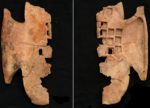 A bronze vessel unearthed from a Qin dynasty tomb still contains a hefty amount of liquor, archaeologists have discovered. The tomb was discovered in a cemetery of commoners’ graves in Yan village, located in China’s Shaanxi province near Xianyang, the ancient capital of the Qin Dynasty. The burials date from the late Warring States period (5th century-221 B.C.) through the Qin Dynasty (221-207 B.C.), and although they have been extensively looted over the centuries, numerous artifacts were found interred in the graves. The bronze kettle was one of several highly significant objects among them.
A bronze vessel unearthed from a Qin dynasty tomb still contains a hefty amount of liquor, archaeologists have discovered. The tomb was discovered in a cemetery of commoners’ graves in Yan village, located in China’s Shaanxi province near Xianyang, the ancient capital of the Qin Dynasty. The burials date from the late Warring States period (5th century-221 B.C.) through the Qin Dynasty (221-207 B.C.), and although they have been extensively looted over the centuries, numerous artifacts were found interred in the graves. The bronze kettle was one of several highly significant objects among them.
 It is a sacrificial vessel, buried for ritual reasons. Interring wine as a sacrificial offering for the dead was a common practice at the time. The jug’s mouth was sealed tight with a coarse hessian fabric, made of jute or sisal fibers, and tied with plant material. It was so effective at blocking air from entering the vessel that even after more than two thousands years, the liquid inside was still fluid when archaeologists removed the stopper. About 300 ml (10 fl oz) of liquid remained. When researchers extracted it, they found it was a cream-colored milky fluid that had undergone a fermentation process in antiquity.
It is a sacrificial vessel, buried for ritual reasons. Interring wine as a sacrificial offering for the dead was a common practice at the time. The jug’s mouth was sealed tight with a coarse hessian fabric, made of jute or sisal fibers, and tied with plant material. It was so effective at blocking air from entering the vessel that even after more than two thousands years, the liquid inside was still fluid when archaeologists removed the stopper. About 300 ml (10 fl oz) of liquid remained. When researchers extracted it, they found it was a cream-colored milky fluid that had undergone a fermentation process in antiquity.
According to Zhang Yanglizheng, an assistant researcher at SPIA, the 300ml of milky-white liquid possess alcoholic substances such hydroxyproline and glutamate. This would suggest that it possesses similar qualities and features to modern-day fermented wine.
The discovery not only reflects the level of wine making in Qin’s capital Xianyang, a prefecture in modern-day Shaanxi Province, at the time, but also shows that the Qin people inherited certain rites and ceremonies from the Western Zhou (1046–771 BCE) period, Zhang explained.
Glutamate and hydroxyproline are non-proteinogenic amino acids. Testing also found small amounts of proteins and fatty acids in the liquor which indicate this ancient tipple was similar to today’s yellow rice wine.
 Another important piece unearthed in the excavation of the cemetery was a bronze sword. Just shy of two feet long (60 cm), the weapon has octahedron-shaped divots in the middle, which were meant to make the weapon easier to wield and thereby increase its effectiveness in battle. Dents and dings along the edge of the sword indicate that it did indeed see use on the battlefield, and a lot of it at that.
Another important piece unearthed in the excavation of the cemetery was a bronze sword. Just shy of two feet long (60 cm), the weapon has octahedron-shaped divots in the middle, which were meant to make the weapon easier to wield and thereby increase its effectiveness in battle. Dents and dings along the edge of the sword indicate that it did indeed see use on the battlefield, and a lot of it at that.
Also found in one of the tombs was a turtle shell, specifically the plastron or bottom half of the shell that covers the animal’s abdomen. It is 14 cm (5.5 inches) long  and has a dozen squares punched out of the shell. There are burn marks along the edge. These features are characteristic symbols used by fortune-tellers to divine the future.
and has a dozen squares punched out of the shell. There are burn marks along the edge. These features are characteristic symbols used by fortune-tellers to divine the future.
The research team is hoping these artifacts and the hundreds of others discovered in the burial ground will shed new light on the social history of people living under the Qin dynasty. Most artifacts of significance that have been recovered from the tombs of the elite. Discovering them in commoners’ graves gives archaeologists a whole new opportunity to examine the daily life of non-nobles in China’s first empire.
“And your fortune is that you shall rise from the grave in 2000 years”